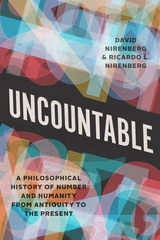101 books about Sustainability & Green Design and 5
start with F
101 books about Sustainability & Green Design and 5
101 books about Sustainability & Green Design
5 start with F start with F
5 start with F start with F
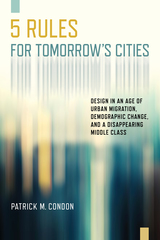
Five Rules for Tomorrow's Cities
Design in an Age of Urban Migration, Demographic Change, and a Disappearing Middle Class
Patrick M. Condon
Island Press, 2019
How we design our cities over the next four decades will be critical for our planet. If we continue to spill excessive greenhouse gas into the atmosphere, we will run out of time to keep our global temperature from increasing. Since approximately 80% of greenhouse gases come from cities, it follows that in the design of cities lies the fate of the world.
As urban designers respond to the critical issue of climate change they must also address three cresting cultural waves: the worldwide rural-to-urban migration; the collapse of global fertility rates; and the disappearance of the middle class. In Five Rules for Tomorrow’s Cities, planning and design expert Patrick Condon explains how urban designers can assimilate these interconnected changes into their work.
Condon shows how the very things that constrain cities—climate change, migration, financial stress, population change—could actually enable the emergence of a more equitable and resource-efficient city. He provides five rules for urban designers: (1) See the City as a System; (2) Recognize Patterns in the Urban Environment; (3) Apply Lighter, Greener, Smarter Infrastructure; (4) Strengthen Social and Economic Urban Resilience; and (5) Adapt to Shifts in Jobs, Retail, and Wages.
In Five Rules for Tomorrow’s Cities, Condon provides grounded and financially feasible design examples for tomorrow’s sustainable cities, and the design tools needed to achieve them.
As urban designers respond to the critical issue of climate change they must also address three cresting cultural waves: the worldwide rural-to-urban migration; the collapse of global fertility rates; and the disappearance of the middle class. In Five Rules for Tomorrow’s Cities, planning and design expert Patrick Condon explains how urban designers can assimilate these interconnected changes into their work.
Condon shows how the very things that constrain cities—climate change, migration, financial stress, population change—could actually enable the emergence of a more equitable and resource-efficient city. He provides five rules for urban designers: (1) See the City as a System; (2) Recognize Patterns in the Urban Environment; (3) Apply Lighter, Greener, Smarter Infrastructure; (4) Strengthen Social and Economic Urban Resilience; and (5) Adapt to Shifts in Jobs, Retail, and Wages.
In Five Rules for Tomorrow’s Cities, Condon provides grounded and financially feasible design examples for tomorrow’s sustainable cities, and the design tools needed to achieve them.
[more]
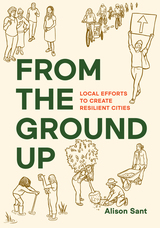
From the Ground Up
Local Efforts to Create Resilient Cities
Alison Sant
Island Press, 2022
For decades, American cities have experimented with ways to remake themselves in response to climate change. These efforts, often driven by grassroots activism, offer valuable lessons for transforming the places we live. In From the Ground Up: Local Efforts to Create Resilient Cities, design expert Alison Sant focuses on the unique ways in which US cities are working to mitigate and adapt to climate change while creating equitable and livable communities. She shows how, from the ground up, we are raising the bar to make cities places in which we don’t just survive, but where all people have the opportunity to thrive.
The efforts discussed in the book demonstrate how urban experimentation and community-based development are informing long-term solutions. Sant shows how US cities are reclaiming their streets from cars, restoring watersheds, growing forests, and adapting shorelines to improve people’s lives while addressing our changing climate. The best examples of this work bring together the energy of community activists, the organization of advocacy groups, the power of city government, and the reach of federal environmental policy.
Sant presents 12 case studies, drawn from research and over 90 interviews with people who are working in these communities to make a difference. For example, advocacy groups in Washington, DC are expanding the urban tree canopy and offering job training in the growing sector of urban forestry. In New York, transit agencies are working to make streets safer for cyclists and pedestrians while shortening commutes. In San Francisco, community activists are creating shoreline parks while addressing historic environmental injustice.
From the Ground Up is a call to action. When we make the places we live more climate resilient, we need to acknowledge and address the history of social and racial injustice. Advocates, non-profit organizations, community-based groups, and government officials will find examples of how to build alliances to support and embolden this vision together. Together we can build cities that will be resilient to the challenges ahead.
The efforts discussed in the book demonstrate how urban experimentation and community-based development are informing long-term solutions. Sant shows how US cities are reclaiming their streets from cars, restoring watersheds, growing forests, and adapting shorelines to improve people’s lives while addressing our changing climate. The best examples of this work bring together the energy of community activists, the organization of advocacy groups, the power of city government, and the reach of federal environmental policy.
Sant presents 12 case studies, drawn from research and over 90 interviews with people who are working in these communities to make a difference. For example, advocacy groups in Washington, DC are expanding the urban tree canopy and offering job training in the growing sector of urban forestry. In New York, transit agencies are working to make streets safer for cyclists and pedestrians while shortening commutes. In San Francisco, community activists are creating shoreline parks while addressing historic environmental injustice.
From the Ground Up is a call to action. When we make the places we live more climate resilient, we need to acknowledge and address the history of social and racial injustice. Advocates, non-profit organizations, community-based groups, and government officials will find examples of how to build alliances to support and embolden this vision together. Together we can build cities that will be resilient to the challenges ahead.
[more]
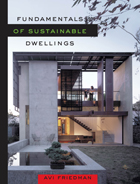
Fundamentals of Sustainable Dwellings
Avi Friedman
Island Press, 2012
Despite a prolonged slump in the housing market, the demand for residential green building remains strong. More than ever, professionals need reliable information about how to construct or retrofit livable, sustainable, and economical homes. With Fundamentals of Sustainable Dwellings, Avi Friedman provides that resource. While other books on residential green building are often either superficial or overly technical, Friedman gets it just right, delivering an illustrated, accessible guide for architects, developers, home builders, codes officials, and students of architecture and green design.
Friedman charts a new course for residential building—one in which social, cultural, economic, and environmental values are part of every design decision. The book begins with a concise overview of green building principles, covering topics such as sustainable resources and common certification methods. Each following chapter examines a critical aspect of green home construction, from siting to waste management options. Friedman provides basics about energy-efficient windows and heating and cooling systems. And he offers innovative solutions like edible landscaping and green roofs.
Friedman knows that in green building, ideas are only as good as their execution. So in each chapter valuable data is assembled and a contemporary project in which designers strove to achieve sustainability while adhering to real-world constraints is featured. The result is a practical guide for every professional in the burgeoning field of residential green building.
Friedman charts a new course for residential building—one in which social, cultural, economic, and environmental values are part of every design decision. The book begins with a concise overview of green building principles, covering topics such as sustainable resources and common certification methods. Each following chapter examines a critical aspect of green home construction, from siting to waste management options. Friedman provides basics about energy-efficient windows and heating and cooling systems. And he offers innovative solutions like edible landscaping and green roofs.
Friedman knows that in green building, ideas are only as good as their execution. So in each chapter valuable data is assembled and a contemporary project in which designers strove to achieve sustainability while adhering to real-world constraints is featured. The result is a practical guide for every professional in the burgeoning field of residential green building.
[more]
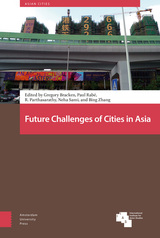
Future Challenges of Cities in Asia
Gregory Bracken
Amsterdam University Press, 2020
The ten essays in *Future Challenges of Cities in Asia* engage with some of the most critical urban questions of the near future across Asia. These comprise socio-economic and cultural transitions as a result of urbanization; environmental challenges, especially questions of climate change, natural disasters, and environmental justice; and the challenges of urban infrastructure, built form, and new emerging types of urban settlements. The essays demonstrate that it is increasingly difficult to conceptualize the ‘urban’ as one particular type of settlement. Rather, it would be more accurate to say that the ‘urban’ characterizes a global transition in the way we are beginning to think about settlements. This book is of interest not only to researchers interested in comparative and inter-disciplinary research, but also to urban practitioners more broadly, illustrating through concrete cases the challenges that urban regions in Asia and beyond are facing, and the various opportunities that exist for dealing with these challenges.
[more]
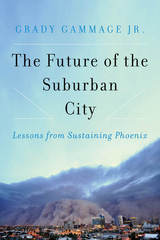
The Future of the Suburban City
Lessons from Sustaining Phoenix
Grady Gammage, Jr.
Island Press, 2016
There exists a category of American cities in which the line between suburban and urban is almost impossible to locate. These suburban cities arose in the last half of twentieth-century America, based largely on the success of the single-family home, shopping centers, and the automobile. The low-density, auto-centric development of suburban cities, which are largely in the arid West, presents challenges for urban sustainability as it is traditionally measured. Yet, some of these cities—Los Angeles, Las Vegas, Phoenix, Salt Lake, Dallas, Tucson, San Bernardino, and San Diego—continue to be among the fastest growing places in the United States.
In The Future of the Suburban City, Phoenix native Grady Gammage, Jr. looks at the promise of the suburban city as well as the challenges. He argues that places that grew up based on the automobile and the single-family home need to dramatically change and evolve. But suburban cities have some advantages in an era of climate change, and many suburban cities are already making strides in increasing their resilience. Gammage focuses on the story of Phoenix, which shows the power of collective action — government action — to confront the challenges of geography and respond through public policy. He takes a fresh look at what it means to be sustainable and examines issues facing most suburban cities around water supply, heat, transportation, housing, density, urban form, jobs, economics, and politics.
The Future of the Suburban City is a realistic yet hopeful story of what is possible for any suburban city.
In The Future of the Suburban City, Phoenix native Grady Gammage, Jr. looks at the promise of the suburban city as well as the challenges. He argues that places that grew up based on the automobile and the single-family home need to dramatically change and evolve. But suburban cities have some advantages in an era of climate change, and many suburban cities are already making strides in increasing their resilience. Gammage focuses on the story of Phoenix, which shows the power of collective action — government action — to confront the challenges of geography and respond through public policy. He takes a fresh look at what it means to be sustainable and examines issues facing most suburban cities around water supply, heat, transportation, housing, density, urban form, jobs, economics, and politics.
The Future of the Suburban City is a realistic yet hopeful story of what is possible for any suburban city.
[more]
READERS
Browse our collection.
PUBLISHERS
See BiblioVault's publisher services.
STUDENT SERVICES
Files for college accessibility offices.
UChicago Accessibility Resources
home | accessibility | search | about | contact us
BiblioVault ® 2001 - 2024
The University of Chicago Press




